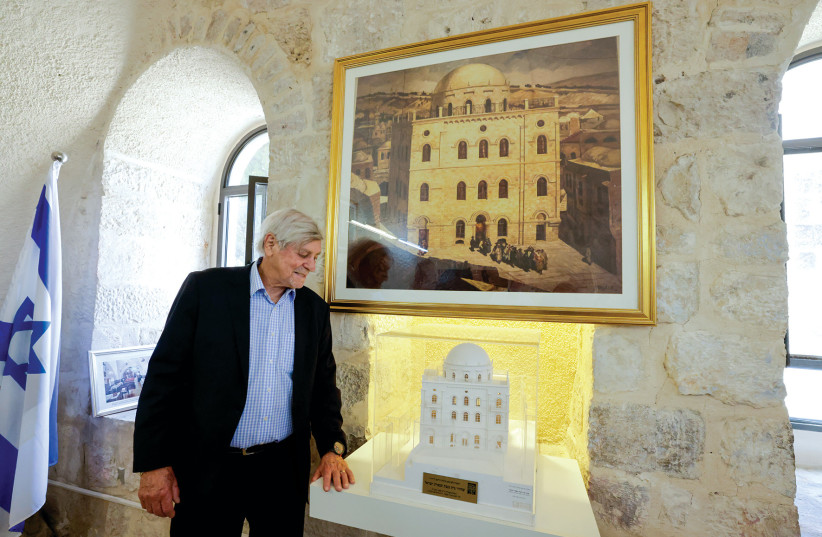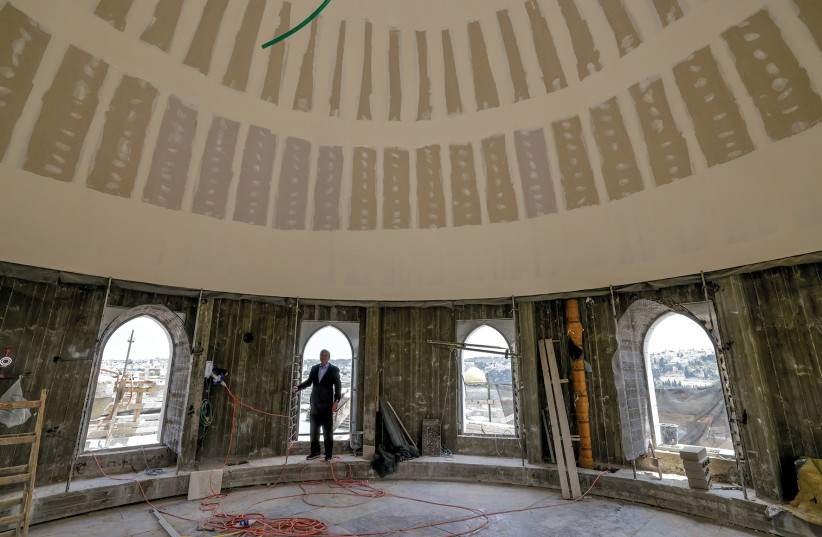Brian Sherr, 79, grew up in New Jersey with one foot in and an eye on the holy city of Jerusalem. His great-great-great-grandfather Rabbi Nissan Bek helped fund and found the Tiferet Israel Synagogue in the 1800s. This synagogue once served as the crown jewel of Jerusalem until it was captured by the Jordanian Arab Legion in the 1948 War of Independence and left for rubble.
Seventy-five years later, Sherr, who now lives in Florida and is a Fort Lauderdale-based Greenberg Traurig real estate shareholder, is playing a pivotal role in funding the synagogue’s restoration.
Sherr first visited the Tiferet Israel Synagogue in 1981 with his cousin.
“It was a pit in the ground filled with garbage,” Sherr recalls. “The main entrance was in shambles. The walls were crumbled. And you would look down, story after story, into the ground.”
But when he closed his eyes, he says he could imagine its grandeur, based on the tales his grandmother used to tell him. His grandmother Mindel “was a strong woman. She was the matriarch of the family. She was born in these dirt flats in the Old City. So I grew up knowing we were from Jerusalem.”

Circumstances brought Mindel and her husband to the States when Sherr’s father was six. The family would visit as often as they could. Then one day, he learned that the government was interested in reestablishing Tiferet Israel. A lawyer with the Tel Aviv branch of his law office established in 2012 – Greenberg-Traurig that has 45 branches worldwide – helped him connect with the project manager. He soon decided to make its rebuilding part of his life’s mission.
Just before the start of the COVID-19 pandemic, he was in Israel laying a cornerstone for the project, which will cost around $16 million to complete. The project is funded by a public and private partnership, with the Israeli government contributing about one-third of the money.
Significant progress has already been made, including to the synagogue’s walls and a gorgeous ancient dome that sits on top. In Sherr’s role as chairman of the nonprofit American Friends of the Old City, he has also contributed and raised funds, including kicking off a $500,000 major fundraising campaign to complete the rebuilding by early 2025.
Sherr has been an active Jewish communal leader for more than 40 years, but this project, he says, will be his legacy.
‘We yearn for Jerusalem’
The Tiferet Israel project is being managed by Daniel Shukron, vice president and project manager of The Company for the Reconstruction and Development of the Jewish Quarter, who, together with Sherr, took The Jerusalem Report on the first tour of the construction site and shared information about the synagogue interior simulations.
He also shared the history he has learned to succeed at the project.
His organization was also behind the restoration of the Hurva Synagogue nearby.
“Tiferet Israel was the symbol of Jewish community life in Jerusalem,” Shukron said. At nearly 80 feet high, it towered over all the other buildings in the area and strengthened the Jewish presence in the holy city. You can see the Western Wall, the Temple Mount and the entire Old City from the top.
The story of Tiferet Israel began in the 1800s when Tsar Nicholas wanted to purchase the land in the Jewish quarter to build a Russian Orthodox church, Shukron explained. Rabbi Bek heard rumors of the tsar’s plans and sought counsel from Rabbi Yisrael Friedman of Rozhin, who commanded him to purchase the property at any price. The rabbi gave Bek a large donation to help make it happen.
Bek had already been raising funds and helping Jews who wanted to move to Jerusalem. Bek returned to Jerusalem and purchased the land. When the tsar caught wind of this, he was angry, forcing Friedman to flee Russia for Sadigora in Ukraine.
It took from 1843 until 1871 to complete the synagogue’s construction, formally inaugurated on the 12th of Av 1872. With its heated mikveh on the bottom floor, banquet halls and boardrooms, the synagogue became a center for all Jewish communal activities – prayers, celebrations, and other gatherings.

Tiferet Israel means “the glory of God,” Shukron said. It was named “Israel” after Friedman. However, everyone knew it as Bek’s synagogue.
Before launching the restoration, archaeologists dug below the surface. They discovered ruins from the First Temple, Second Temple, Byzantine, Mamluk, Ottoman and modern eras.
In 1948, Jewish members of the Hagana used Tiferet Israel as a stronghold against the Arab Legion. However, it was ultimately captured, and the Jewish residents of Jerusalem were exiled through the Zion Gate.
In 1967, the Jews won back Jerusalem and, with it, the site of the Tiferet Israel synagogue, which Sherr says signifies for him the Zionist dream and the glory of the Jewish people in their land.
The restoration will include a visitor’s center, where these stories will be told.
The 34-feet circumference dome atop the building will also be open so visitors can stand there and view the city’s splendor.
Sherr said the synagogue’s restoration is in his genes.
“I imagine my great-great-great-grandfather standing here and looking at the synagogue. He did that. I am doing it. And, God willing, others will follow us here,” he said. “We yearn for Jerusalem. That is what we always did as a people. Now we have it.”
Sherr said he does not plan to move to Israel but hopes to purchase a place in the Old City near the synagogue. He has three daughters and five grandchildren, and he envisions them knowing and loving the holy city, too.
“Tiferet Israel is symbolic of the Jewish people rebuilding ourselves,” said Sherr. ■
